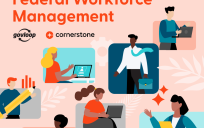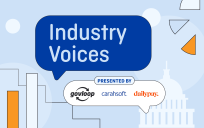In the early 2000s, the manager of the Oakland Athletics began using players’ performance data to build a better baseball team. Chris Curry, Director of Homeland Security and Justice Issues at the GAO, believes that the government should do the same. His GAO report, titled “Federal Emergency Management Agency: Additional Planning and Data Collection Could Help Improve Workforce Management Efforts,” details the steps that federal agencies must take to achieve their goals.
In an interview with Chris Dorobek on the DorobekINSIDER program, Curry discussed two takeaways from his report that could make the government’s workplaces and workforces more efficient.
“Data is critical to make decisions, and it’s no different for workforce issues,” Curry said. Today, many federal agencies do not track project costs and performance data that would allow them to measure their workforce’s efficacy. “If you don’t have all of the information for how much it costs you to actually execute and implement your workforce, then, you really don’t know how effective it is, whether you need more or less of it, or what kind of a job it’s doing,” he said.
Performance data is not only critical to assess employees, but it also outlines clear expectations for an agency’s workforce to meet. When workers know exactly what’s expected of them, they’re more likely to meet their agency’s needs. It seems like common sense; however, a number of federal agencies still do not collect and integrate performance data into their decision-making process.
For example, the FEMA Corps program, which deploys 18 to 24-year-old employees to the field during disasters, did not have a way to determine if these teams finished their assigned tasks. “FEMA wasn’t really looking to see whether these teams of folks that went out were doing what they were supposed to be doing,” Curry said. “They were given a certain project to complete, but no one was ever really following up to see whether they actually met their goals.”
Knowing whether a new workforce is helping or hurting your agency, and being able to assess whether your agency will need that workforce in the future, is critical information. Without this basic cost and performance data, agencies are left clueless as to whether they are achieving their mission.
Aside from more comprehensive data collection, Curry asserted that, “workforce planning is so critical, not just at FEMA, but all parts of the government, because federal agencies have to have the people with the right skills, at the right time, to have a chance of achieving their missions.”
For FEMA, workforce planning and assessments have been special challenges. Their mix of full-time, conditional, contract, and part-time employees ready to respond to disasters make it difficult to collect data, let alone integrate it into their workforce planning process. Different parts of FEMA have not yet integrated their human capital efforts. One FEMA office might be set on accomplishing one goal, while another might be working toward an entirely different project. The problem, according to Curry, is that these projects have not been synced across the agency or assessed to see if there are overlaps or gaps between them.
At an agency that is, out of necessity, always planning, launching new initiatives and projects, and bringing in new employees to prepare for disaster, it seems imperative that there be synchronized efforts across the organization and real measures of success. “Until they integrate these efforts, none of these challenges are really going to be addressed,” Curry said.
Strategic human capital management “is not just an issue at FEMA. It’s an issue across the federal government,” Curry said. According to the most recent Federal Employee Viewpoint Survey, FEMA ranked 281 out of 315 organizations in employee morale. The government’s largest agencies did not fair much better. Low morale hinders an agency’s ability to achieve its goals and overall mission. “That’s why strategic human capital plans at the highest level within the agency that identify workforce needs, workforce gaps, and goals and measures are so critical,” Curry said.
Agencies don’t have to spend a lot of money or set up steering committees to accomplish their goals. Curry contended that instead, federal organizations should take more action to gather better data. Collecting cost and performance data will help agencies make smarter decisions about their workforce.
With this information, government organizations can strategically manage their human capital, assess what works, what doesn’t and ultimately make more informed decisions about what changes need to be made. Data-driven decisions like these have the power to transform federal agencies into more efficient bodies that serve citizens better.





Having worked with the dedicated young FEMACorps trmembers, I can say that I was truly inspired by their energy and camaraderie. It’s a shame that we don’t focus on their contributions and accomplishments. However, this is no different than how we treat most Federal employees. We focus on getting them onboard and then neglect to provide systems for tracking accomplishments, collect feedback, or developing their skills. This neglect results in lower FEVS scores.